Light, in a restaurant, as a non-marginal element. In fact, the contrary.
Light as vision, as well as emotion.
Light as mystery, deepness and seduction
These words are taken from Incontroluce, Davide Groppi’s book, reviewing the 30-year-long career of this brilliant designer from Piacenza, born in 1963, the heir of friend and master Ingo Maurer who unites art, design and architecture. Groppi’s career started in a miniscule lab in the heart of his town, in the Eighties. Today his marvellous works are celebrated everywhere; the Edida award in 2011 for Sampei, the Design Plus award in 2014 for Neuro, the double Compasso d’Oro Adi (it’s considered the most historic and prestigious acknowledgement in the world of design, like the Academy awards) in 2014 for lamps Nulla and Sampei, and again the Menzione d’Onore Compasso d’Oro Adi forTetatet in 2016. And then, he’s the author of the lighting in many of the most important restaurants: Le Calandre, Osteria Francescana, Mirazur, Enigma, Madonnina del Pescatore, Casa Perbellini... And even Identità Golose Milano, but before then, Identità Expo in 2015.
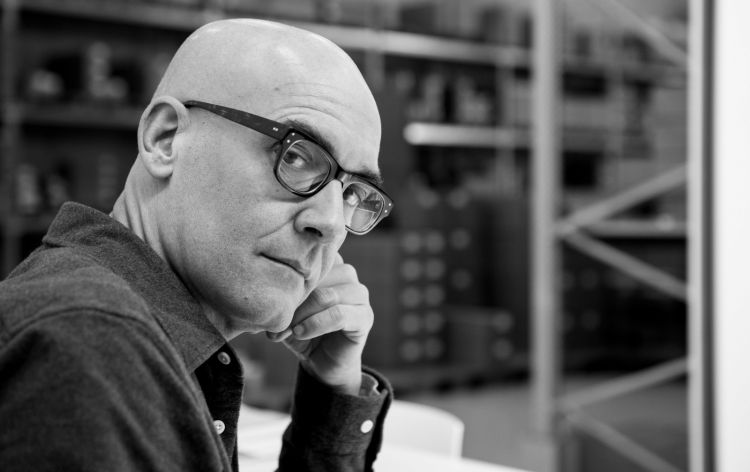
Indeed Groppi, for a few years now, has dedicated his attention to the world of food, to restaurants; he did it a bit by chance, a bit by vocation, finding fertile soil because nobody before him had thought and created specific solutions that would light up the most prestigious dining rooms in the world. Groppi has always said very little about all this. He did so with us, over lunch, a few weeks ago. In the meantime, let’s start from the beginning.
Light as vision, as well as emotion.
Light as mystery, deepness and seduction
Light as an ingredient
Light on a plate
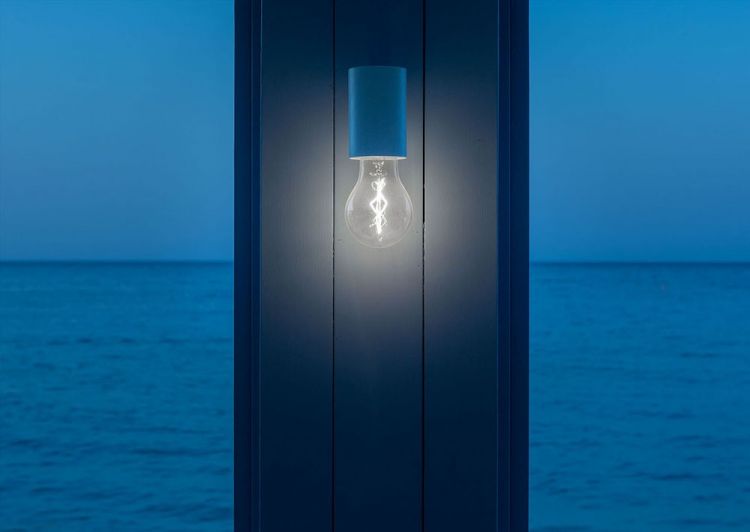
Edivad by Davide Groppi, 2012. Here, at Moreno Cedroni’s Il Clandestino
We added two elements, to those mentioned above. Here it is: "The light on the plate". This concept was also the theme of a dinner that took place recently at Identità Golose Milano, during which Groppi told a large group of architects «not the rules, but what in our opinion are the best choices to be made to light a restaurant effectively». But is there a basic rule? «The main one: light is a cooking ingredient. The light of Caravaggio, for instance, can often be found in my work, regardless of the place where I’m working. And there’s another rule: give people the opportunity, through lights, that is to say through the lights on the plate, to feel like they’re the only guests in the restaurant, even when it’s full. To me, this is crucial». Creating, through a play of lights, an island for each table, so that the gastronomic experience can be as intimate as possible. And on top of that, we add, it allows taking the best possible photos of the plate, something that today is particularly important for social communication.
Groppi has been studying these solutions for less than a decade. Yet today some of his bestsellers, like Tetatet and Sampei, have been chosen to light the most important restaurants in Italy and beyond. It all began almost by chance, in an unexpected way: through fortuitous meetings and coincidences the designer met three prominent people in the restaurant industry: Massimiliano Alajmo, Massimo Bottura and Moreno Cedroni. «I landed in the world of restaurants by chance. I never thought: "Masterchef is coming, everyone will speak of food, cooking, conviviality, so let’s get going too". I made no calculations».
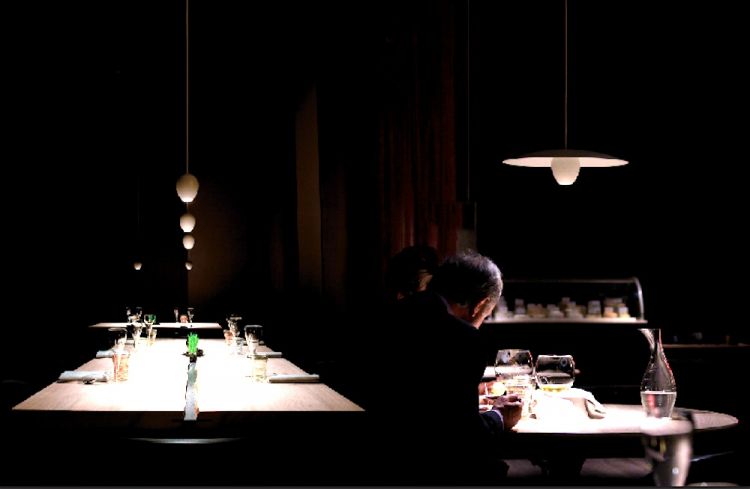
The Ovo and Ovonelpiatto lamps at Le Calandre in Rubano (Padua). A project of Davide Groppi’s from 2010, both are signed by Massimiliano and Raffaele Alajmo
MASSIMILIANO ALAJMO - «One day, some ten years ago, I found out that the Alajmo brothers had bought some of my lamps. We talked and this soon resulted in a joint project», that led to the creation of some pieces that have now become iconic an to this day shine on Le Calandre: on top of lamp Punto, which was already from 2004, in 2010 came the new Ovo and Ovonelpiatto, a concept of "lighting egg" signed by Max&Raf themselves, making use of the beam of light created by a simple 3.5 W Led light, but made more powerful through a lens that determines its direction and intensity.
The light on the plate is the most beautiful light.
It allows us to feel we’re the only guests in a restaurant,
it makes us experience a true multisensorial experience.
But, above all, it transforms a table into a place of meeting and of love.
Groppi is proud of his work: «Le Calandre is a beautiful place, especially at night. Outside, the place is nothing special; inside, it shows my concept of light design in the best possible way. Our work there was in the sense of “light on the plate”, very simply».
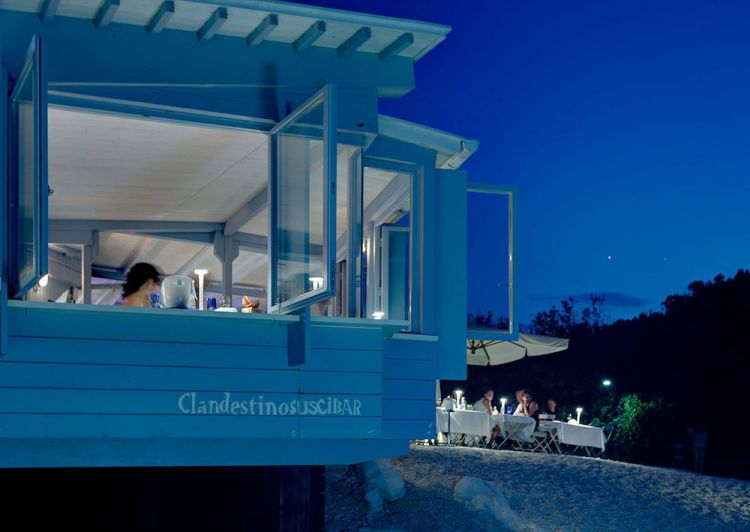
Lighting by Davide Groppi at Cedroni’s Il Clandestino
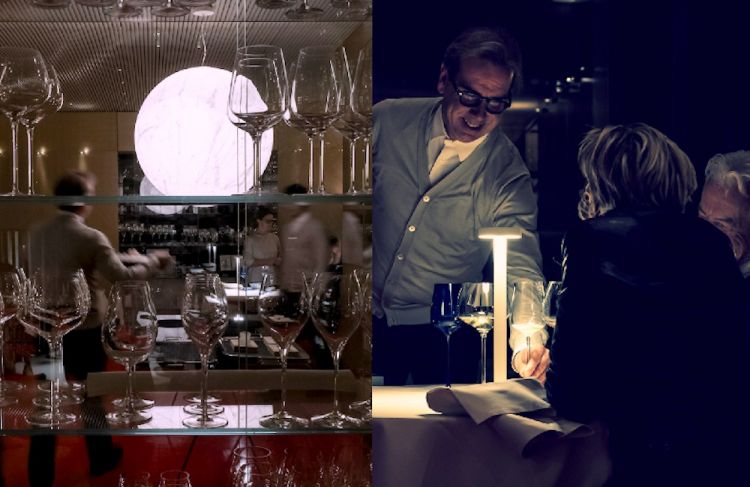
Moon (Davide Groppi, 2005) and Tetatet at Madonnina del Pescatore
–
Groppi and
Moreno Cedroni’s acquaintace was also born almost by chance. In November 2012 a storm destroyed
Il Clandestino.
Moreno and his wife
Mariella handed an architect the works necessary to reopen in the late spring of the following year. In the end, they realised that that professional had not done a good job with the lighting. They didn’t want to start from scratch, break the walls, create new ducts. They contacted
Groppi. «At that time, I had created a wireless lamp in partnership with
Christofle, a prestigious French jewellers that makes fine silverware and home accessories». It was a silver lamp that had to be placed in the middle of a tray, «the French didn’t fully get its potential. They sold it for a huge price and besides they considered as a display piece, while in my opinion it had to be used, it had to live».
Cedroni’s call arrived at the perfect time: that lamp – no longer in silver, but in white – could represent the perfect solution for
Il Clandestino. It’s the famous
Tetatet, which we now find in many restaurants and people have tried to imitate many times. Later
Groppi curated also the light design at
Madonnina del Pescatore.
Mariella Organi recalls with a smile: «He arrived here, studied the lights, and the only lamp that he allowed us to keep was
Achille and
Pier Giacomo Castiglioni’s
Toio».
Groppi: «I don’t know if this is how it went. But until recently at
Il Clandestino clients were welcomed with lamps on the walls, their lights only slightly dimmed. The lights were disappointing, very disappointing. But then the first course was the light itself, the
Tetatet lamp. I think this is beautiful».
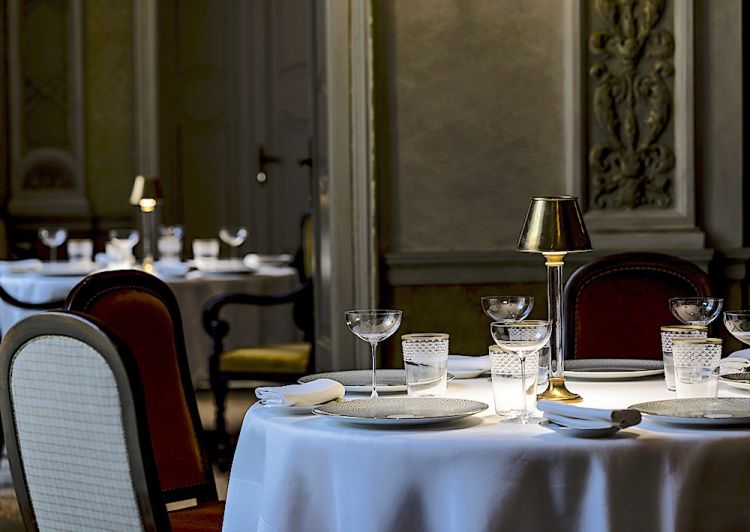
Tetatet by Davide Groppi, an exclusive edition for Carlo Cracco at Cracco in Galleria, 2018
– Prior to this lamp, there were no battery-powered table solutions. Or rather, there were some, but they were essentially gadgets, they did not give proper light: as in the case of
New Flame, from the above-mentioned
Maurer. «In our case, instead, with Tetatet we launched a new product category: a portable table-light, battery-powered, as a lighting tool that really solves the problem».
Groppi adds: «The white
Tetatet is an almost perfect project. It’s a work based on minimum size: the stalk includes a battery of the smallest possible size, smaller than this, it would not be possible; in the same way, the top includes an optical part of the smallest size; the base can be placed under that tablecloth and allows to create a feeling of almost unstable balance». Over the years,
Tetatet has also become a glass or a source of music; there are special editions, like the golden one designed for
Carlo Cracco in
Galleria. And now, how about the possible developments? «Who knows. I’ve researched the wireless part, which has generated many further series. Now I’ve stopped a little: everyone is offering similar lamps, and I don’t want to take part myself in this proliferation».
SAMPEI -
Tetatet is the best-selling lamp in
Davide Groppi’s career. Those who often visit fine dining restaurants know this well. Yet in terms of revenues there’s another lamp that beats it, and can also be found in the most important dining rooms and offices (including
Sergio Mattarella’s office at the Quirinale palace):
Sampei. «I’ve been producing it since 2011. But the idea came earlier, in 2008: I was dining with my friend
Enzo Calabrese and we were discussing things to do. I love
readymade things. We thought we’d like to make a lamp with a fishing rod, a
readymade that is; we were thinking of
Castiglioni’sToio lamp...». These thoughts had an outcome three years later: «
Euroluce was approaching. I was in my hangar, I tried to extend a fishing rod by applying a source of light at its end. This is how
Sampei was born. We showed it immediately and we realised it would be a success»,
Compasso d'oro in 2014 together with
Nulla.
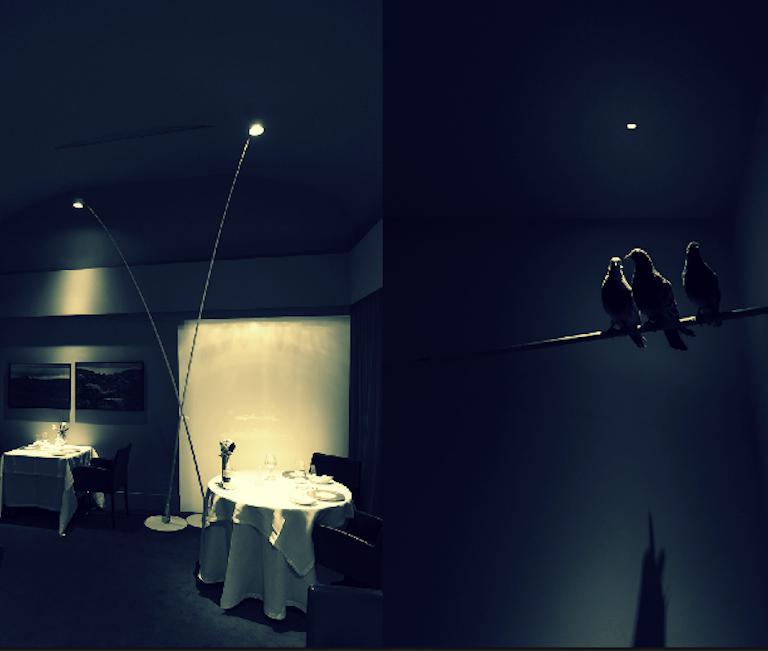
Sampei andNulla lamps (2010) at Osteria Francescana
MASSIMO BOTTURA – When speaking of Sampei and Nulla, however, of course one thinks of another great Italian figure: Massimo Bottura. Davide Groppi, long before working in Senigallia, signed another lighting project at Osteria Francescana, «Massimo wanted great lighting: on top of Miralamps, he chose Nulla (for the entrance and the corridor) and the white Sampei (for the dining room with four tables) even before they were awarded».
A few selected pieces seeking beauty while chasing truth. Light on the plate and in the eyes of people. Everything is researched with care, in a combination of art, music, food, scents, life
(World Architects)
Now these lamps are also to be found in Bottura’s new project, Casa Maria Luigia, the country house in the countryside of Modena, where they are used with other works from Groppi, like Infinito.

A diagram of Nulla, in which light and darkness are inverted. The number 18 refers to the millimetres of diameter
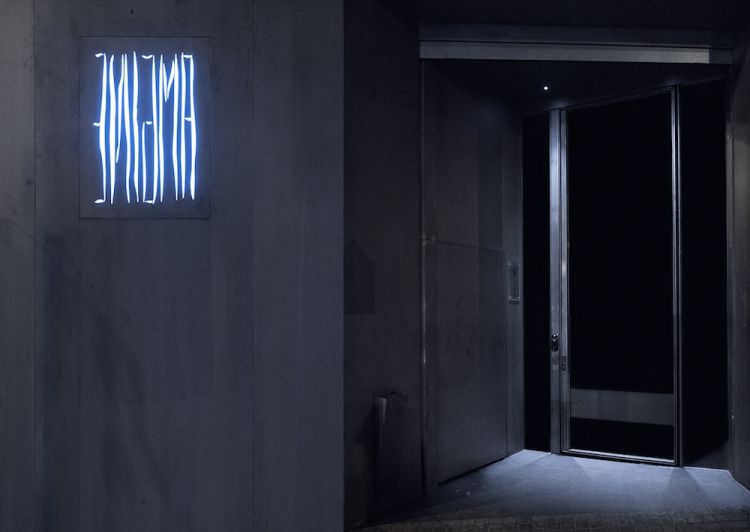
Nulla (that spot on the right) shines over the entrance of Albert Adrià Enigma in Barcelona
NULLA - «Nulla is my favourite lamp: total lightness. When it was born, I thought: it will be published everywhere, and we will sell very few. In fact, the opposite occurred. It’s all based on one powerful light. It was born in 2010: before the mono-dimensional led light arrived in our fields, and before so called secondary optics, that is to say when you place a led light in front of a lens. It was born with the goal of illuminating the table». Bottura uses it, as mentioned, as well as Cracco or Albert Adrià, at his Enigma in Barcelona.
Nulla is an extreme research on the theme of subtraction.
Light is researched and presented as a pure physical phenomenon. The research of a “source-less light” led me to consider the possibility of creating an invisible, magical and illusory project.
A very simple idea: a hole in the ceiling. A hole only 18 mm wide, a special optic system and led technology create a marvellous light on the table. A deep and sensual light
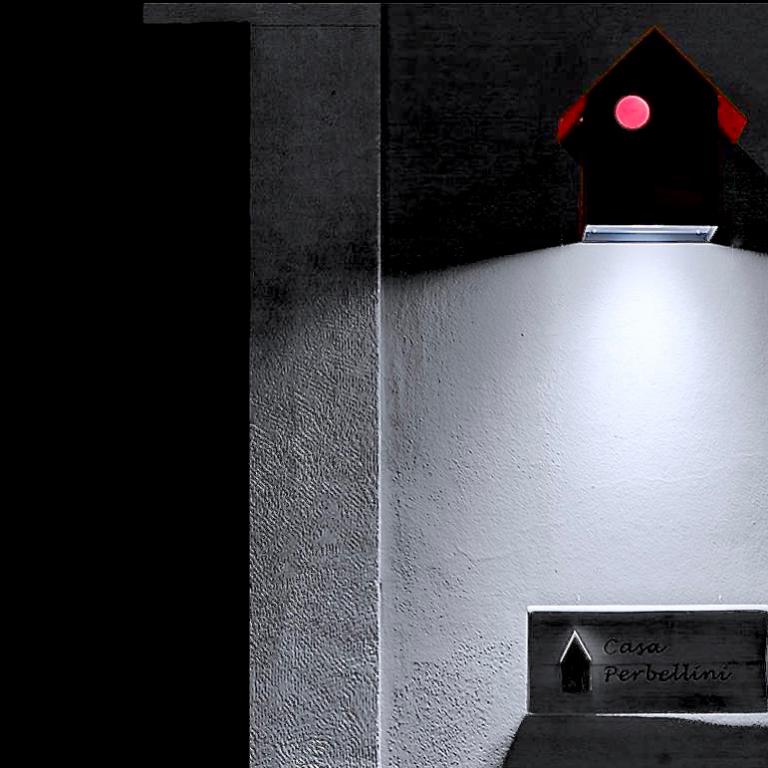
Imu by Groppi shining over the entrance at Casa Perbellini
GIANCARLO PERBELLINI - «Giancarlo is great - Davide says – I happened to work for him in his restaurant in Verona, which is small. So I had the opportunity of experimenting on location a series of tricks that later resulted in new products». The connection between the two men can be represented by an elegant choice: to illuminate the sign over his restaurant, the chef chose Imu, a lamp by Groppi that recreates the profile of a home-nest, and hence illuminates the emblem of Casa Perbellini, which is a stylised house. A perfect symbiosis, in other words.
Imu is a lamp created to welcome, to shine over the entrance.
Imu is the only house where you don’t pay taxes…
In Piazza San Zeno, in Verona, we illuminated the new restaurant of Giancarlo Perbellini.
In Casa Perbellini the kitchen becomes a stage.
The chef and his work enter the scene creating a unique connection with the guests, with no boundaries.
Arriving at Casa Perbellini is like enjoying the most intimate and exclusive dining atmosphere, it’s like dining at the chef’s home.
This is why we have chosen, once again ”the light on the plate”.
So that people can experience light as a crucial cooking ingredient.
At Casa Perbellini one can also find Folder, Mira, Tetatet and Moon, which is also at Madonnina del Pescatore.
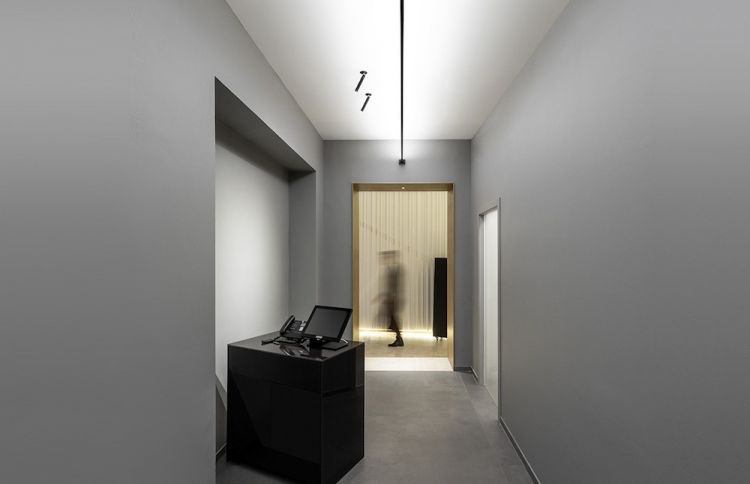
Groppi’s lighting design for Identità Golose Milano: here there are the Infinito (Groppi, 2016) and Mira R lamps (Omar Carraglia, 2012)
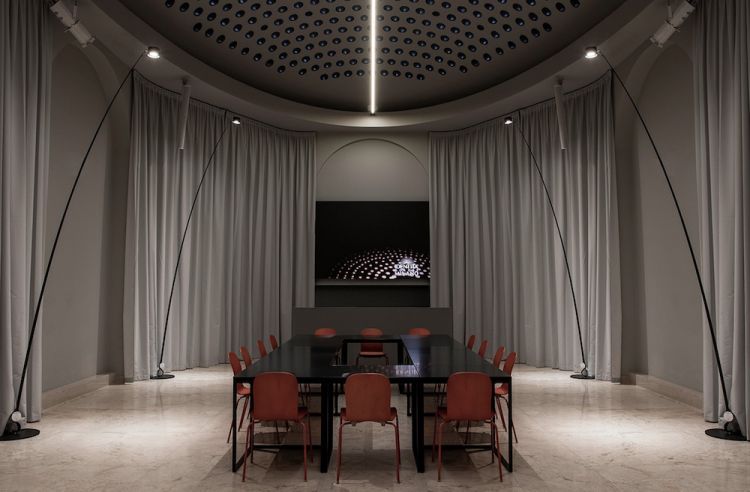
Sampei lamps in the Oval room at Identità Golose Milano

Miss (Omar Carraglia, 2006) and Tetatet in the dining room of the restaurant in Via Romagnosi 3
IDENTITÀ GOLOSE MILANO - «How come I’ve become a partner of Identità Golose Milano, lighting their rooms? To put it simply, I try to work with people I like. With you, with Paolo, Claudio, the other Claudio, I work well. My life is made of fortuitous meetings, and this is how Identità Golose also arrived. I’d say the project works, with architect Tordera we decided to light the entire space, not just the table. But in the evening, I recommend to dim the lights above, and use almost only those on the tables», the Tetatet flûte, to recreate that effect of light on the plate, therefore making it possible for people to feel like they are the only guests of the restaurant, even when it’s full.
Davide Groppi’s light for Identità Golose Milano suggests journeys, evokes spaces, caresses tables. It becomes an ingredient in the kitchen.
Direct light, indirect light, for an authentic multisensorial experience
In Via Romagnosi 3 one can find the Flash, Infinito, Mira R, Miss, Nulla, Sampei, Solemio and Tetatet flute lamps.
FOOD LIGHTING – Our short report would not be complete unless we mentioned another food project from Davide Groppi, - «it’s rather an experiment» he smiles – that is to say Lemon Ledon (2012), a real "food lighting" study (with no production line). It’s made of four lemons that, connected in a series, create the necessary energy for a luminous diode. Therefore, it’s not just about lighting food, but about lighting food through food.
A series of photos of some of Groppi’s most important light projects in Italian and foreign restaurants follows.
Translated by Slawka G. Scarso
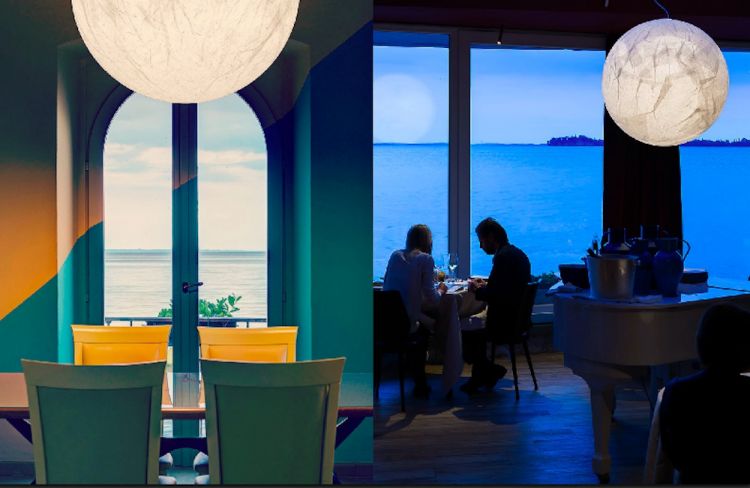
Moon lamps at Riccardo Camanini’s Lido 84. It’s made with Japanese paper
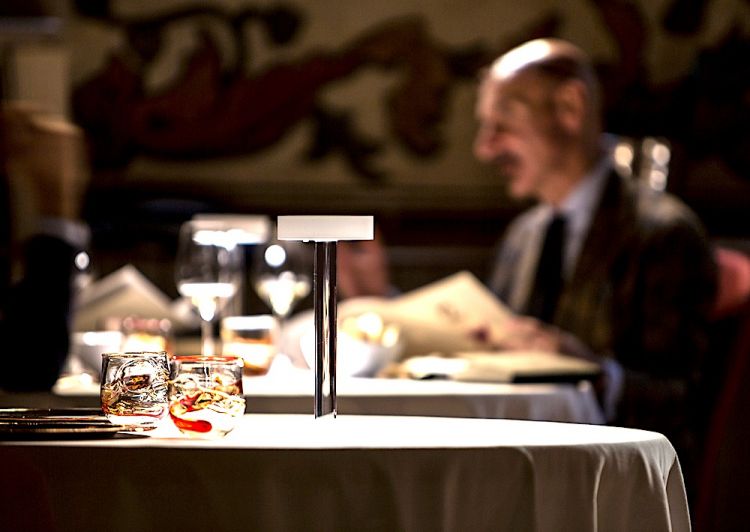
Tetatet flûte (Groppi, 2017) at 12 Apostoli in Verona
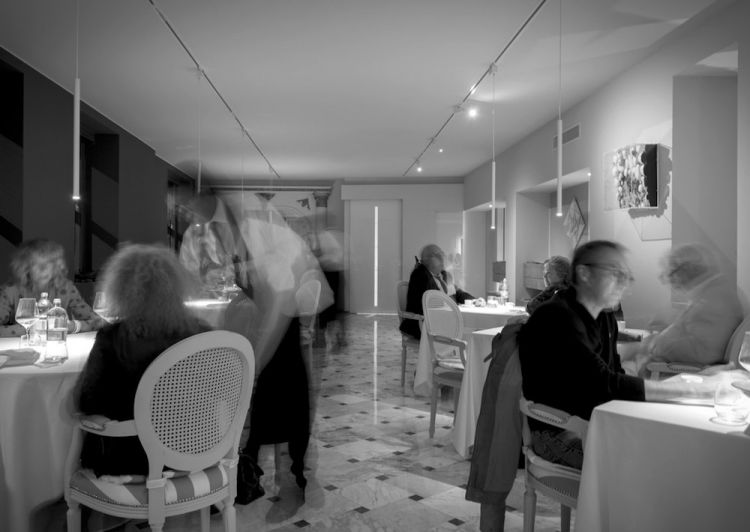
Miss at I Due Buoi in Alessandria, a project designed in the days of Andrea Ribaldone
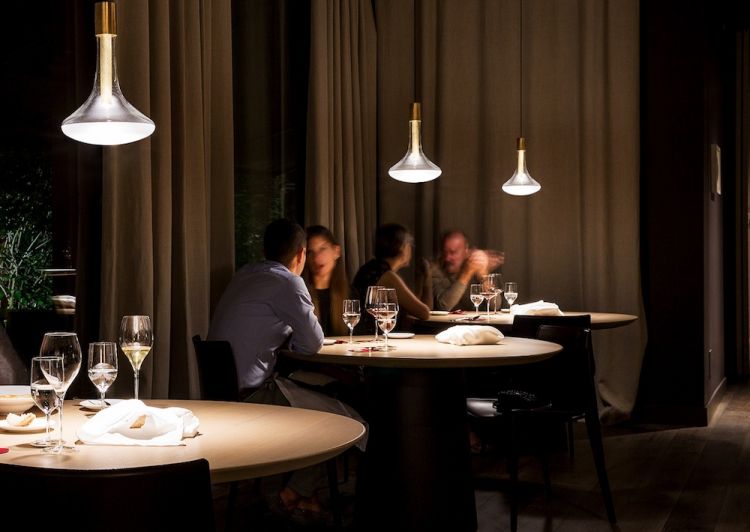
Cathode (Omar Carraglia, 2015) at restaurant Marconi in Sasso Marconi, with chef Aurora Mazzucchelli
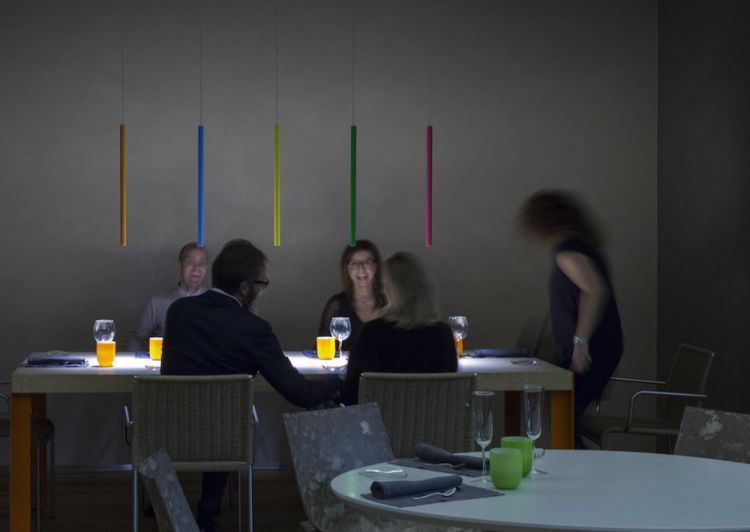
Some Miss lamps at Giuliano Baldessari’s Aqua Crua near Vicenza. The lamps are customised with colours designed by Groppi together with the chef
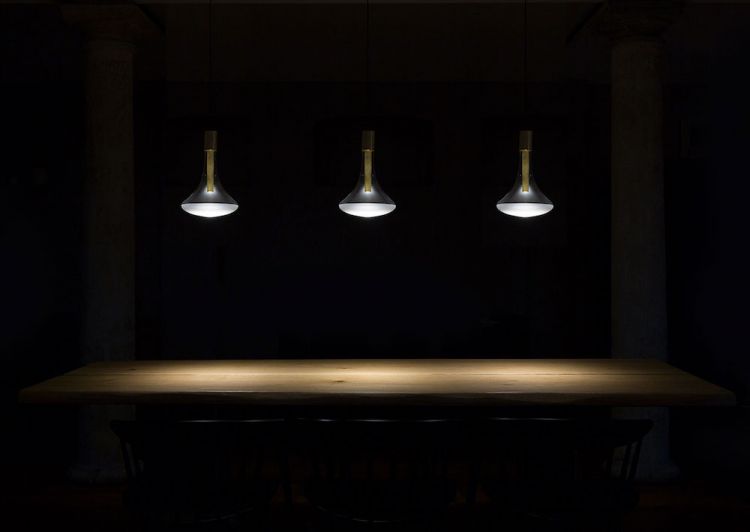
Cathode (Omar Carraglia, 2015) at Andrea Incerti Vezzani’s restaurant Ca' Matilde in Quattro Castella (Reggio Emilia)
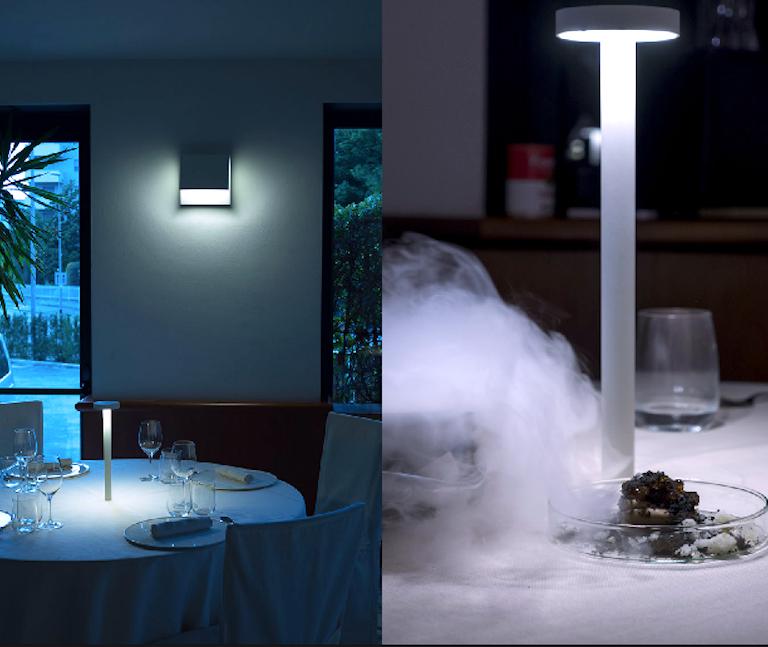
Davide Groppi’s project for Christian and Manuel Costardi’s restaurant in Vercelli (2015)
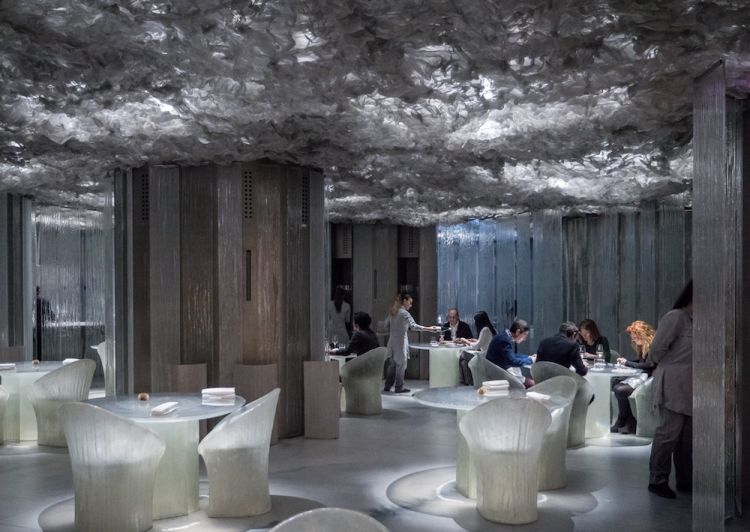
The lights at Albert Adrià’s Enigma curated by Davide Groppi: Nulla lamps filtered so as to «make each table “unique and magic”»
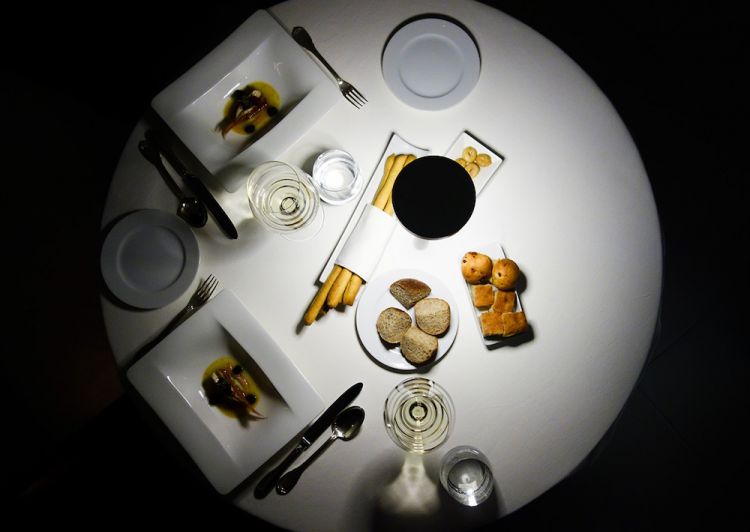
Tetatet on the table at Gennaro Esposito’s Torre del Saracino
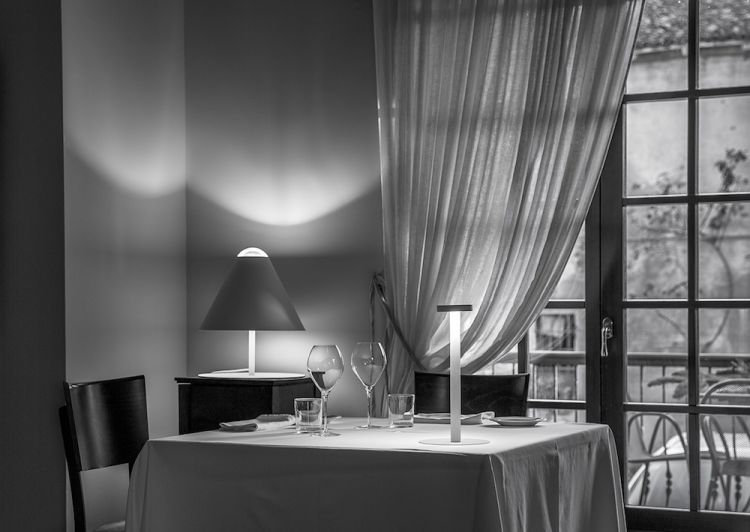
Aba 45 (Omar Carraglia, 2007) and Tetatet at La Palta in Borgonovo Val Tidone, chef Isa Mazzocchi
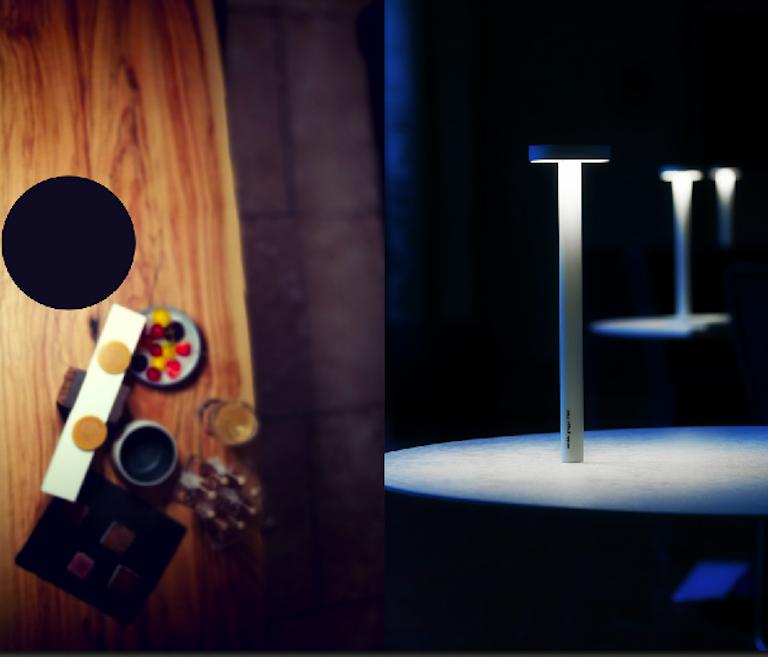
Tetatet in the number one restaurant according to theWorld’s 50Best: Mauro Colagreco’s Mirazur in Mentone